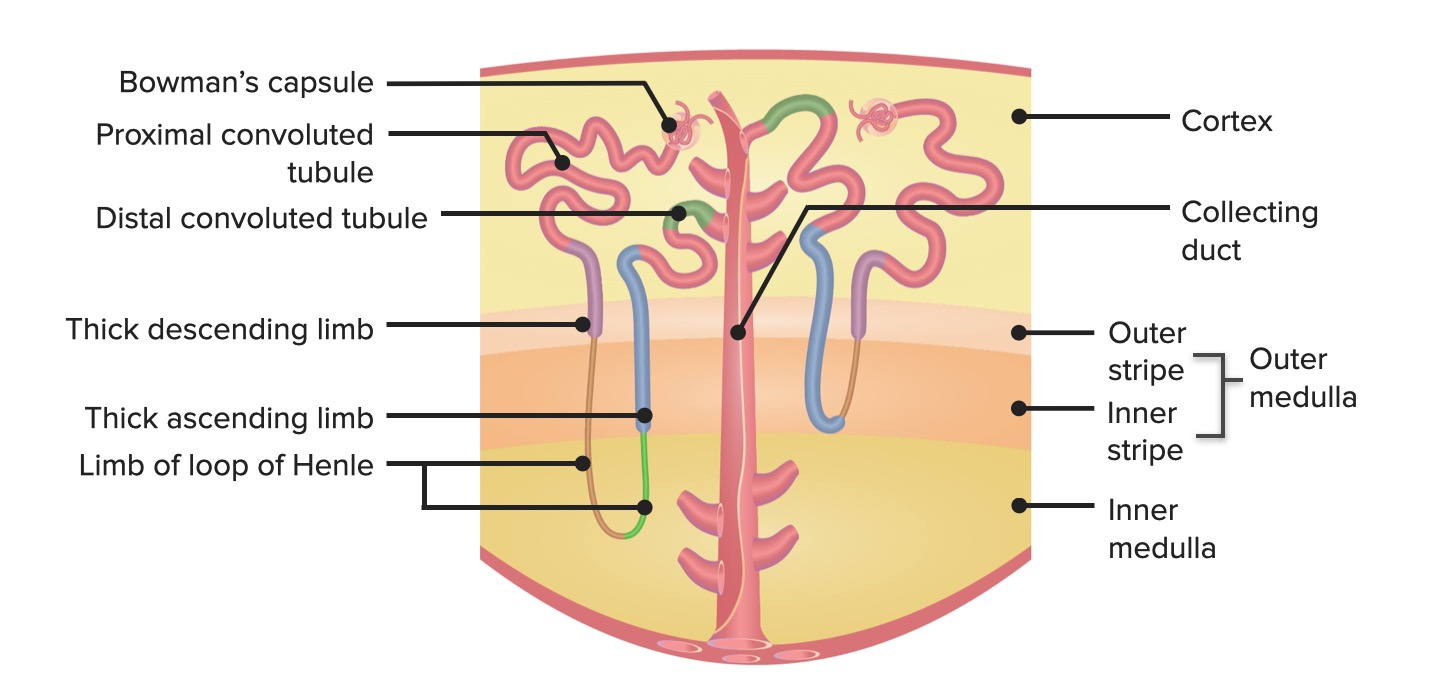Playlist
Show Playlist
Hide Playlist
Hypokalemia: Diagnosis and Treatment
-
Slides Potassium Disorders Hypo and Hyperkalemia.pdf
-
Download Lecture Overview
00:01 So once we have that patient sitting in front of us, what are some important things that we can do to arrive at the correct diagnosis so that we can fix the underlying problem. 00:11 The first thing is we definitely want to take a good clinical history. 00:13 We want to help to determine where that source of potassium loss is coming from. 00:18 Do they have either transcellular shift. 00:20 Do they have GI losses, or do they have renal losses? We want to look at that urinary potassium determination. 00:27 So distinct that is very helpful to distinguish between urinary losses from shift or GI losses. 00:34 So I can look at something called the urinary potassium to creatinine ratio. 00:38 So again that's going to assume a 24-hour value of urinary potassium based on a spot sample because most patients generate about a gram of creatinine. 00:46 If I take an aliquot of 10 mils of urine and I take that and measure the potassium value as well as the creatinine value that's going to give me a good idea of what that patient is losing within a 24-hour period of time. 00:58 Now a ratio of less than 15 Milli equivalents per gram of creatinine is going to suggest that that kidney is working and it has appropriate conservation of potassium and that the loss of potassium that they're incurring is extra renal. 01:13 It's either from GI or transcellular shift. 01:16 If my patient has greater than 15 Milli equivalents per gram of creatinine, then that suggests that urinary losses are occurring. 01:25 Now I also want to determine the acid-based status of my patient because that will also help me diagnostically in terms of what's going on. 01:32 If they have for example a metabolic acidosis. 01:36 And they have a low urinary potassium to creatinine ratio. 01:40 Then this could be due to things like stool losses. 01:43 It could be if they have a high urinary potassium to creatinine ratio meaning that it's greater than 15 Milli equivalents per gram. 01:49 Then I know they have renal losses and if I'm thinking about renal and association with a metabolic acidosis, it's either going to an RTA or it's going to be a non reabsorbable anion. 02:00 Now if I have a patient who has metabolic alkalosis and they have a low urinary potassium to creatinine ratio, then I think about vomiting that's not sustained over time. 02:10 But if they have a high unary potassium to creatinine ratio, meaning that they have renal losses. 02:15 Then the next thing I want to do is I want to check their blood pressure and their volume status. 02:20 If they have a lowish blood pressure or they appear that their volume depleted. 02:24 I'm automatically thinking that this patient may he be using diuretics. 02:27 They might have a salt wasting of frothy like Barrter's or Gitelman's or they had can have ongoing vomiting with a sustained metabolic alkalosis in urinary losses from that. 02:37 If my patient has a high blood pressure or their volume overloaded, then I think about states like mineralocorticoid excess or Littles the other thing that you want to do when you're determining where this potassium loss is coming from as you always always want to check your magnesium. 02:52 Remember you cannot correct hypokalemia, unless magnesium is corrected. 02:57 So in terms of treatment, it's very important to decipher what the underlying disorder is so that we can correct that. 03:03 When the potassium is extremely low less than 2.5 milli equivalents per liter, It's going carry a risk of dangerous cardiac arrhythmias and that needs to be replaced urgently. 03:12 There's a couple of different ways that we can replace so if somebody has mild hypokalemia, we can give them oral replacement. 03:20 But if somebody has severe hypokalemia, or they can't take oral intake then we can do parenteral replacement or IV replacement. 03:28 So the maximum potassium chloride concentration that we can actually deliver as about 20 milliequivalents per 100ml. 03:34 So do keep that in mind, and we want to administer at a maximum rate of 10 Milli equivalents per hour. 03:40 So when a patient is extraordinarily hypokalemic, then we can only deliver so much parenteral potassium.
About the Lecture
The lecture Hypokalemia: Diagnosis and Treatment by Amy Sussman, MD is from the course Potassium Disorders: Hypo- and Hyperkalemia.
Included Quiz Questions
Which of the following statements is correct regarding the management of hypokalemia?
- Parenteral potassium replacement is indicated when serum potassium level is < 2.5 mEq/L.
- Hypokalemia cannot be corrected unless calcium is corrected.
- Oral potassium replacement is indicated in patients with persistent severe vomiting.
- The maximum rate of parenteral potassium administration is 12 mEq/L.
- The maximum KCL concentration in parenteral potassium replacement is 40 mEq/ 100 mL.
Which of the following is associated with Liddle's syndrome?
- High potassium-to-creatinine ratio
- Metabolic acidosis
- Low blood pressure
- Hyperreninism
- Orthostatic hypotension
Customer reviews
5,0 of 5 stars
| 5 Stars |
|
5 |
| 4 Stars |
|
0 |
| 3 Stars |
|
0 |
| 2 Stars |
|
0 |
| 1 Star |
|
0 |





